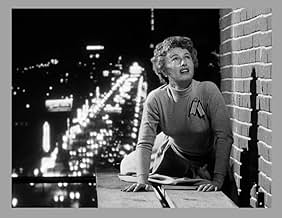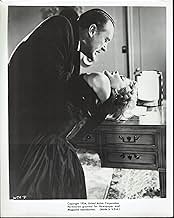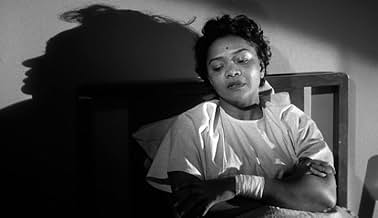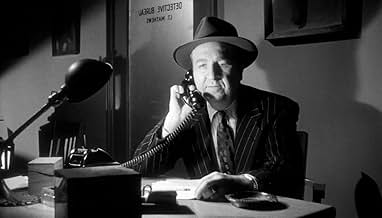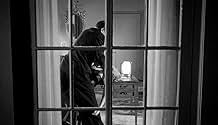IMDb रेटिंग
6.6/10
3.7 हज़ार
आपकी रेटिंग
अपनी भाषा में प्लॉट जोड़ेंA woman's sanity comes into question after she claims to have witnessed a murder from her apartment window.A woman's sanity comes into question after she claims to have witnessed a murder from her apartment window.A woman's sanity comes into question after she claims to have witnessed a murder from her apartment window.
- निर्देशक
- लेखक
- स्टार
Adeline De Walt Reynolds
- The Old Lady
- (as Adeline de Walt Reynolds)
Claude Akins
- Police Officer
- (बिना क्रेडिट के)
Ralph Brooks
- Man at Lunch Counter
- (बिना क्रेडिट के)
Russell Custer
- Police Officer
- (बिना क्रेडिट के)
Sam Edwards
- Tommy
- (बिना क्रेडिट के)
Jean Fenwick
- Nurse
- (बिना क्रेडिट के)
Fred Graham
- Plainclothes Man
- (बिना क्रेडिट के)
फ़ीचर्ड समीक्षाएं
"Witness to Murder" is a small but interesting film starring Barbara Stanwyck, George Sanders, and Gary Merrill. By 1954, Stanwyck was 47 and no longer considered leading lady material. However, because she was such a great star and actress, she could still get good roles in big films, "Titanic" and "Executive Suite" being two that leap to mind. She could also, like Loretta Young, get stuck in B movies like this one and "Jeopardy." "Witness to Murder" isn't so much a B movie as it is closer to what one was seeing on television by 1954. And it's not a B cast.
Stanwyck plays a career woman, Cheryl, of a certain age who sees a woman murdered in the apartment across from hers. The apartment belongs to an author, Albert Richter, who emigrated to America after the war. Cheryl reports the murder but no one believes her. Richter is too smooth and always one step ahead of her with the police. Cheryl is considered an hysterical single woman who has delusions because she isn't married and probably going through menopause, though this isn't out and out stated. Completely outrageous and no doubt what actually went on at the time. These assumptions were just taken for granted in the '50s. There was something really wrong with a woman who never married. Read LOSER. A woman's goal in life was marriage; the career was just a stopgap until the ring was on the finger. What must it have been like for an intelligent woman to have that mantle put on her. In this film, the police detective (Gary Merrill) is interested enough in her to at least follow the case.
All of the acting is very good, with Stanwyck really shining as someone determined to get the truth out, even if she has to do a little detective work herself. Sanders is very effective as the villainous Richter, and he's pretty scary at the end of the film. The last 15 minutes or so are exciting and will have you on the edge of your seat.
This is actually a fairly derivative film bolstered by its stars. And you can't beat the opportunity to see the attitudes toward women played out in a realistic manner. Alas, there are still touches of it today.
Stanwyck plays a career woman, Cheryl, of a certain age who sees a woman murdered in the apartment across from hers. The apartment belongs to an author, Albert Richter, who emigrated to America after the war. Cheryl reports the murder but no one believes her. Richter is too smooth and always one step ahead of her with the police. Cheryl is considered an hysterical single woman who has delusions because she isn't married and probably going through menopause, though this isn't out and out stated. Completely outrageous and no doubt what actually went on at the time. These assumptions were just taken for granted in the '50s. There was something really wrong with a woman who never married. Read LOSER. A woman's goal in life was marriage; the career was just a stopgap until the ring was on the finger. What must it have been like for an intelligent woman to have that mantle put on her. In this film, the police detective (Gary Merrill) is interested enough in her to at least follow the case.
All of the acting is very good, with Stanwyck really shining as someone determined to get the truth out, even if she has to do a little detective work herself. Sanders is very effective as the villainous Richter, and he's pretty scary at the end of the film. The last 15 minutes or so are exciting and will have you on the edge of your seat.
This is actually a fairly derivative film bolstered by its stars. And you can't beat the opportunity to see the attitudes toward women played out in a realistic manner. Alas, there are still touches of it today.
The John Alton photography is layered thick and shadowy in this late Film-Noir entry. Almost every scene is back lit with diagonals and impressions draping the proceedings and it is this atmospheric artistic display that highlights this often filmed story.
The characters and conventions of the Noir cycle by this time have become familiar but the shear broad strokes of the style are undeniably effective. The odd take on the villain being of Nazi descent with delusions of grandeur while meant to be of a deep personality flaw, is obtrusive and distracts from believability. It is an unwanted and unneeded take on the psychological persona of the killer.
The mental hospital scene is a standout as is the finale through the construction site. The only drag is the relentless unbelieving of the authorities that wears out its welcome fast but in the long view does not hold the film back from its better parts.
The characters and conventions of the Noir cycle by this time have become familiar but the shear broad strokes of the style are undeniably effective. The odd take on the villain being of Nazi descent with delusions of grandeur while meant to be of a deep personality flaw, is obtrusive and distracts from believability. It is an unwanted and unneeded take on the psychological persona of the killer.
The mental hospital scene is a standout as is the finale through the construction site. The only drag is the relentless unbelieving of the authorities that wears out its welcome fast but in the long view does not hold the film back from its better parts.
In addition to its solid performances, tight storytelling and John Alton's superior cinematography, what makes "Witness to Murder" particularly powerful today is the movie's pre-feminist view of its leading character's dilemma. "But I saw the murder, I SAW the murder," the Stanwyck character insists. Yet no one believes her because 1) she's a woman; 2) she's unmarried; 3) she's menopausal. Nobody even blinks an eye when she's dumped in a mental hospital, which gets viewers really riled because they share her point of view. The audience sees the murder along with Stanwyck and can feel her humiliation, anger and frustration. That's why the movie works.
It's interesting that both this film and "Rear Window" came out in the same year, since the base plot is identical: person witnessess murder through apartment window in opposing apartment and spends rest of movie trying to convince everone else what they saw. While the Hitchcock movie is more stylish and elaborate, this film definitely keeps your attention. Typical of movies of the 50's, the villain is disposed of in the climax, thereby eliminating any necessity of bringing them to justice. Stanwyck, as usual, gives her best "woman in distress", hysterical performance.
Witness to Murder (1954)
** 1/2 (out of 4)
Great performances are somewhat wasted in this thriller that simply has way too many logical problems to really work. Cheryl (Barbara Stanwyck) wakes up one night and looks across the street to an open window where she sees a man (George Sanders) kill a woman. Cheryl goes to the police but they don't believe her and after a while they start to think she's the one that is crazy. She strikes up a relationship with the lead detective (Gary Merrill) but the only person who knows she's telling the truth is the killer himself. WITNESS TO MURDER features three great performances from the leads but sadly there are just way too many logic issues that keep this from being a complete winner. As many other reviewers have pointed out, there were times where I wanted to jump through the screen and just smack the detective and those helping on this case. It doesn't help that right from the start no one is taking the woman serious because if anyone had done the smallest amount of work then there were all sorts of signs that she was telling the truth. Another big problem is that the Sanders character can pretty much do whatever he wants, no matter how silly it is, and the police will never question it. After a while you pretty much just have to throw your hands in the air. Another major problem I had was with the music score, which was just constantly on and being way too dramatic for its own good. With that said, the three leads really make the film worth watching and especially Sanders who is terrific as the villain. He does a great job at playing this rather dark character and I loved the way the actor played it up to scare Stanwyck while playing it cool and collective whenever facing the police. Director Roy Rowland does a nice job with the ending, which contains some suspense but sadly the screenplay doesn't give him more to work with.
** 1/2 (out of 4)
Great performances are somewhat wasted in this thriller that simply has way too many logical problems to really work. Cheryl (Barbara Stanwyck) wakes up one night and looks across the street to an open window where she sees a man (George Sanders) kill a woman. Cheryl goes to the police but they don't believe her and after a while they start to think she's the one that is crazy. She strikes up a relationship with the lead detective (Gary Merrill) but the only person who knows she's telling the truth is the killer himself. WITNESS TO MURDER features three great performances from the leads but sadly there are just way too many logic issues that keep this from being a complete winner. As many other reviewers have pointed out, there were times where I wanted to jump through the screen and just smack the detective and those helping on this case. It doesn't help that right from the start no one is taking the woman serious because if anyone had done the smallest amount of work then there were all sorts of signs that she was telling the truth. Another big problem is that the Sanders character can pretty much do whatever he wants, no matter how silly it is, and the police will never question it. After a while you pretty much just have to throw your hands in the air. Another major problem I had was with the music score, which was just constantly on and being way too dramatic for its own good. With that said, the three leads really make the film worth watching and especially Sanders who is terrific as the villain. He does a great job at playing this rather dark character and I loved the way the actor played it up to scare Stanwyck while playing it cool and collective whenever facing the police. Director Roy Rowland does a nice job with the ending, which contains some suspense but sadly the screenplay doesn't give him more to work with.
क्या आपको पता है
- ट्रिवियाIn an unusual connection for the time (or possibly a product placement), the W&J Sloane Company in Beverly Hills - where Cheryl worked - was a real furniture and interior decorating firm founded in New York City in 1843. It went bankrupt in 1985. According to the end credits, the company supplied set decorations and furnishings for the film.
- गूफ़The story is taking place in Los Angeles, but the map on the wall in Larry's office is that of San Francisco.
- भाव
[repeated line]
The Old Lady - Mental Patient: Show Mr. Peabody into the library please.
- कनेक्शनFeatured in Frances Farmer Presents: Witness to Murder (1959)
टॉप पसंद
रेटिंग देने के लिए साइन-इन करें और वैयक्तिकृत सुझावों के लिए वॉचलिस्ट करें
विवरण
- रिलीज़ की तारीख़
- कंट्री ऑफ़ ओरिजिन
- भाषाएं
- इस रूप में भी जाना जाता है
- Testigo del crimen
- फ़िल्माने की जगहें
- Linda Vista Apartments, 939 S. Serrano Ave., लॉस एंजेल्स, कैलिफोर्निया, संयुक्त राज्य अमेरिका(Cheryl Draper's apartment building)
- उत्पादन कंपनी
- IMDbPro पर और कंपनी क्रेडिट देखें
- चलने की अवधि
- 1 घं 23 मि(83 min)
- रंग
- पक्ष अनुपात
- 1.75 : 1
इस पेज में योगदान दें
किसी बदलाव का सुझाव दें या अनुपलब्ध कॉन्टेंट जोड़ें

![Trailer [EN] देखें](https://m.media-amazon.com/images/M/MV5BYjI4NDBiYmQtN2U0MS00MTdjLWI0YzEtODBkYjE0YjQ1MDc4XkEyXkFqcGdeQXRyYW5zY29kZS13b3JrZmxvdw@@._V1_QL75_UX500_CR0)
